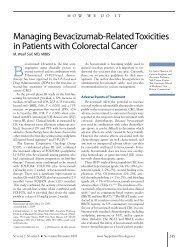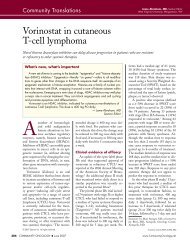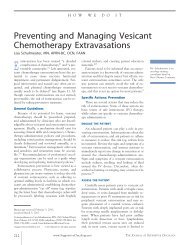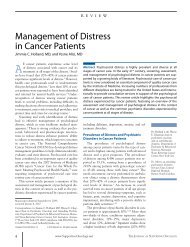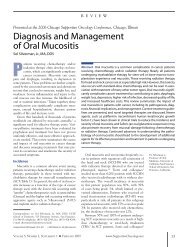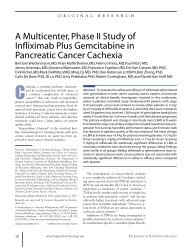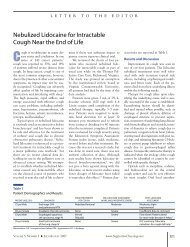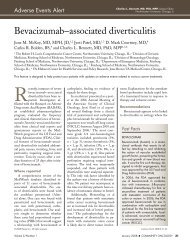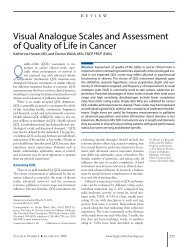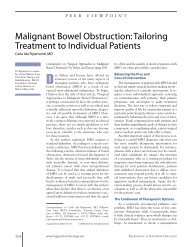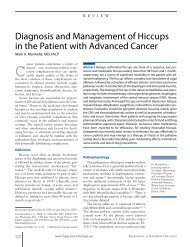Impact of Zoledronic Acid on Renal Function in Patients With Cancer ...
Impact of Zoledronic Acid on Renal Function in Patients With Cancer ...
Impact of Zoledronic Acid on Renal Function in Patients With Cancer ...
You also want an ePaper? Increase the reach of your titles
YUMPU automatically turns print PDFs into web optimized ePapers that Google loves.
McDermott, Kloth, Wang, et al<br />
Because these patients have advanced or metastatic cancer,<br />
it is possible that the number <str<strong>on</strong>g>of</str<strong>on</strong>g> doses received may be a surrogate,<br />
at least <strong>in</strong> part, for progressi<strong>on</strong> <str<strong>on</strong>g>of</str<strong>on</strong>g> disease and overall<br />
deteriorati<strong>on</strong> <strong>in</strong> multiple systems. In licens<strong>in</strong>g studies, the <strong>in</strong>cidence<br />
<str<strong>on</strong>g>of</str<strong>on</strong>g> renal deteriorati<strong>on</strong> appeared to be related to the time<br />
<strong>on</strong> study, whether the patients were receiv<strong>in</strong>g zoledr<strong>on</strong>ic acid,<br />
pamidr<strong>on</strong>ate, or placebo. 2,3,5,11 This relati<strong>on</strong> was also reflected <strong>in</strong><br />
the analysis <str<strong>on</strong>g>of</str<strong>on</strong>g> our own patient populati<strong>on</strong> with renal deteriorati<strong>on</strong>,<br />
<strong>in</strong> many <str<strong>on</strong>g>of</str<strong>on</strong>g> whom it was a preterm<strong>in</strong>al event. F<strong>in</strong>ally, age<br />
is an accepted risk factor for the development <str<strong>on</strong>g>of</str<strong>on</strong>g> renal failure,<br />
most likely due to the accumulati<strong>on</strong> <str<strong>on</strong>g>of</str<strong>on</strong>g> comorbid illnesses. 17<br />
On multivariate analysis, we did not f<strong>in</strong>d a significant relati<strong>on</strong>ship<br />
between an elevated basel<strong>in</strong>e serum creat<strong>in</strong><strong>in</strong>e level<br />
and renal deteriorati<strong>on</strong>, as described <strong>in</strong> the package <strong>in</strong>sert. 18 This<br />
f<strong>in</strong>d<strong>in</strong>g may be attributable to the fact that the degree <str<strong>on</strong>g>of</str<strong>on</strong>g> basel<strong>in</strong>e<br />
renal functi<strong>on</strong> impairment was not severe <strong>in</strong> these patients. In a<br />
small pharmacok<strong>in</strong>etic study <str<strong>on</strong>g>of</str<strong>on</strong>g> 19 cancer patients stratified by<br />
creat<strong>in</strong><strong>in</strong>e clearance, 19 dosage adjustment <str<strong>on</strong>g>of</str<strong>on</strong>g> zoledr<strong>on</strong>ic acid did<br />
not appear to be necessary <strong>in</strong> patients with mild to moderate renal<br />
impairment. N<strong>on</strong>etheless, zoledr<strong>on</strong>ic acid is not recommended <strong>in</strong><br />
patients with serum creat<strong>in</strong><strong>in</strong>e levels > 3 mg/dL, and cauti<strong>on</strong> is<br />
advisable <strong>in</strong> all patients with impaired renal functi<strong>on</strong>. 18<br />
Us<strong>in</strong>g these risk factors, we have c<strong>on</strong>structed a model that<br />
can be used to predict the likelihood <str<strong>on</strong>g>of</str<strong>on</strong>g> an <strong>in</strong>dividual patient<br />
develop<strong>in</strong>g renal deteriorati<strong>on</strong> with the use <str<strong>on</strong>g>of</str<strong>on</strong>g> zoledr<strong>on</strong>ic acid.<br />
We chose a cut<str<strong>on</strong>g>of</str<strong>on</strong>g>f po<strong>in</strong>t <str<strong>on</strong>g>of</str<strong>on</strong>g> 10%, as it is similar to the previously<br />
published <strong>in</strong>cidence <str<strong>on</strong>g>of</str<strong>on</strong>g> renal deteriorati<strong>on</strong> with zoledr<strong>on</strong>ic<br />
acid 2–5 and represents a level <str<strong>on</strong>g>of</str<strong>on</strong>g> risk above which cl<strong>in</strong>icians may<br />
wish to proceed more cautiously. The risk-factor pr<str<strong>on</strong>g>of</str<strong>on</strong>g>ile and the<br />
accompany<strong>in</strong>g model potentially could be used by physicians <strong>in</strong>volved<br />
<strong>in</strong> the treatment <str<strong>on</strong>g>of</str<strong>on</strong>g> patients with metastatic cancer when<br />
calculat<strong>in</strong>g the risk-benefit ratio associated with zoledr<strong>on</strong>ic acid<br />
therapy as an adjunct to other anticancer therapies.<br />
It is important to note, however, that the review <str<strong>on</strong>g>of</str<strong>on</strong>g> the cases<br />
<strong>in</strong> this series <strong>in</strong> which there was evidence <str<strong>on</strong>g>of</str<strong>on</strong>g> renal deteriorati<strong>on</strong><br />
dem<strong>on</strong>strated that the rise <strong>in</strong> creat<strong>in</strong><strong>in</strong>e level was <str<strong>on</strong>g>of</str<strong>on</strong>g>ten<br />
mild and not cl<strong>in</strong>ically significant <strong>in</strong> the eyes <str<strong>on</strong>g>of</str<strong>on</strong>g> the treat<strong>in</strong>g<br />
physician. In many <strong>in</strong>stances, zoledr<strong>on</strong>ic acid therapy was c<strong>on</strong>t<strong>in</strong>ued<br />
without sequelae. Moreover, <strong>in</strong> other patients, renal<br />
deteriorati<strong>on</strong> was a preterm<strong>in</strong>al event, with evidence <str<strong>on</strong>g>of</str<strong>on</strong>g> widely<br />
progressive disease, a general deteriorati<strong>on</strong> <strong>in</strong> performance<br />
status, and a switch to symptom-based care. This f<strong>in</strong>d<strong>in</strong>g is<br />
c<strong>on</strong>sistent with the fact that <strong>on</strong>ce bisphosph<strong>on</strong>ate therapy is<br />
begun for treatment <str<strong>on</strong>g>of</str<strong>on</strong>g> b<strong>on</strong>e metastasis, it is <str<strong>on</strong>g>of</str<strong>on</strong>g>ten c<strong>on</strong>t<strong>in</strong>ued<br />
until the decisi<strong>on</strong> is made to end active cancer therapy. N<strong>on</strong>etheless,<br />
there are patients <strong>in</strong> whom use <str<strong>on</strong>g>of</str<strong>on</strong>g> zoledr<strong>on</strong>ic acid will<br />
<strong>in</strong>duce a rise <strong>in</strong> serum creat<strong>in</strong><strong>in</strong>e level that may drop up<strong>on</strong><br />
disc<strong>on</strong>t<strong>in</strong>uati<strong>on</strong> <str<strong>on</strong>g>of</str<strong>on</strong>g> the drug, and our model is unable to differentiate<br />
between these differ<strong>in</strong>g patient types.<br />
C<strong>on</strong>clusi<strong>on</strong><br />
<str<strong>on</strong>g>Zoledr<strong>on</strong>ic</str<strong>on</strong>g> acid must be regarded as a potentially nephrotoxic<br />
agent, similar to many other medicati<strong>on</strong>s used <strong>in</strong> the<br />
treatment <str<strong>on</strong>g>of</str<strong>on</strong>g> patients with cancer. However, the impact <str<strong>on</strong>g>of</str<strong>on</strong>g><br />
m<strong>on</strong>itor<strong>in</strong>g renal functi<strong>on</strong> before each dose <str<strong>on</strong>g>of</str<strong>on</strong>g> zoledr<strong>on</strong>ic<br />
acid effectively negates the time advantage <str<strong>on</strong>g>of</str<strong>on</strong>g> the <strong>in</strong>fusi<strong>on</strong>,<br />
as patients typically must wait for laboratory results before<br />
commenc<strong>in</strong>g therapy. Regular m<strong>on</strong>itor<strong>in</strong>g <str<strong>on</strong>g>of</str<strong>on</strong>g> serum creat<strong>in</strong><strong>in</strong>e<br />
levels <strong>in</strong> these patients represents good cl<strong>in</strong>ical practice;<br />
there are many reas<strong>on</strong>s why renal functi<strong>on</strong> might deteriorate<br />
<strong>in</strong> patients with advanced disease. Based <strong>on</strong> the available<br />
data, m<strong>on</strong>itor<strong>in</strong>g <str<strong>on</strong>g>of</str<strong>on</strong>g> serum creat<strong>in</strong><strong>in</strong>e levels before each dose<br />
<str<strong>on</strong>g>of</str<strong>on</strong>g> zoledr<strong>on</strong>ic acid is given appears warranted <strong>in</strong> patients at<br />
high risk for renal deteriorati<strong>on</strong>; however, compulsive creat<strong>in</strong><strong>in</strong>e<br />
level m<strong>on</strong>itor<strong>in</strong>g is burdensome and expensive and may<br />
not be necessary <strong>in</strong> all patients.<br />
References<br />
1. Green JR, Muller K, Jaeggi KA. Precl<strong>in</strong>ical pharmacology<br />
<str<strong>on</strong>g>of</str<strong>on</strong>g> CGP 42’446, a new, potent, heterocyclic bisphosph<strong>on</strong>ate<br />
compound. J B<strong>on</strong>e M<strong>in</strong>er Res 1994;9:745–751.<br />
2. Rosen LS, Gord<strong>on</strong> D, Tchekmedyian S, et al.<br />
<str<strong>on</strong>g>Zoledr<strong>on</strong>ic</str<strong>on</strong>g> acid versus placebo <strong>in</strong> the treatment <str<strong>on</strong>g>of</str<strong>on</strong>g><br />
skeletal metastases <strong>in</strong> patients with lung cancer and<br />
other solid tumors: a phase III, double-bl<strong>in</strong>d, randomized<br />
trial—the <str<strong>on</strong>g>Zoledr<strong>on</strong>ic</str<strong>on</strong>g> <str<strong>on</strong>g>Acid</str<strong>on</strong>g> Lung <strong>Cancer</strong> and Other Solid<br />
Tumors Study Group. J Cl<strong>in</strong> Oncol 2003;21:3150–3157.<br />
3. Saad F, Gleas<strong>on</strong> DM, Murray R, et al. A randomized,<br />
placebo-c<strong>on</strong>trolled trial <str<strong>on</strong>g>of</str<strong>on</strong>g> zoledr<strong>on</strong>ic acid <strong>in</strong> patients<br />
with horm<strong>on</strong>e-refractory metastatic prostate carc<strong>in</strong>oma.<br />
JNCI <strong>Cancer</strong> Spectrum 2002;94:1458–1468.<br />
4. Ibrahim A, Scher N, Williams G, et al. Approval<br />
summary for zoledr<strong>on</strong>ic acid for treatment <str<strong>on</strong>g>of</str<strong>on</strong>g> multiple<br />
myeloma and cancer b<strong>on</strong>e metastases. Cl<strong>in</strong> <strong>Cancer</strong> Res<br />
2003;9:2394–2399.<br />
5. Rosen LS, Gord<strong>on</strong> D, Kam<strong>in</strong>ski M, et al. <str<strong>on</strong>g>Zoledr<strong>on</strong>ic</str<strong>on</strong>g><br />
acid versus pamidr<strong>on</strong>ate <strong>in</strong> the treatment <str<strong>on</strong>g>of</str<strong>on</strong>g> skeletal<br />
metastases <strong>in</strong> patients with breast cancer or osteolytic<br />
lesi<strong>on</strong>s <str<strong>on</strong>g>of</str<strong>on</strong>g> multiple myeloma: a phase III, double-bl<strong>in</strong>d,<br />
comparative trial. <strong>Cancer</strong> J 2001;7:377–387.<br />
6. Markowitz GS, F<strong>in</strong>e PL, Stack JI, et al. Toxic acute<br />
tubular necrosis follow<strong>in</strong>g treatment with zoledr<strong>on</strong>ate<br />
(Zometa). Kidney Int 2003;64:281–289.<br />
7. Chang JT, Green L, Beitz J. <strong>Renal</strong> failure with the use<br />
<str<strong>on</strong>g>of</str<strong>on</strong>g> zoledr<strong>on</strong>ic acid. N Engl J Med 2003;349:1676–1679.<br />
8. We<strong>in</strong>man EJ, Patak RV. Acute renal failure <strong>in</strong><br />
cancer patients. Oncology (Hunt<strong>in</strong>gt) 1992;6:47–52;<br />
discussi<strong>on</strong> 52–54.<br />
9. Banerjee D, Asif A, Striker L, et al. Short-term, highdose<br />
pamidr<strong>on</strong>ate-<strong>in</strong>duced acute tubular necrosis: the<br />
postulated mechanisms <str<strong>on</strong>g>of</str<strong>on</strong>g> bisphosph<strong>on</strong>ate nephrotoxicity.<br />
Am J Kidney Dis 2003;41:E18.<br />
10. Markowitz GS, Appel GB, F<strong>in</strong>e PL, et al. Collaps<strong>in</strong>g<br />
focal segmental glomerulosclerosis follow<strong>in</strong>g treatment<br />
with high-dose pamidr<strong>on</strong>ate. J Am Soc Nephrol<br />
2001;12:1164–1172.<br />
11. Rosen LS, Gord<strong>on</strong> D, Kam<strong>in</strong>ski M, et al. L<strong>on</strong>gterm<br />
efficacy and safety <str<strong>on</strong>g>of</str<strong>on</strong>g> zoledr<strong>on</strong>ic acid compared<br />
with pamidr<strong>on</strong>ate disodium <strong>in</strong> the treatment <str<strong>on</strong>g>of</str<strong>on</strong>g><br />
skeletal complicati<strong>on</strong>s <strong>in</strong> patients with advanced<br />
multiple myeloma or breast carc<strong>in</strong>oma: a randomized,<br />
double-bl<strong>in</strong>d, multicenter, comparative trial. <strong>Cancer</strong><br />
2003;98:1735–1744.<br />
12. Blade J, Fernandez-Llama P, Bosch F, et al. <strong>Renal</strong><br />
failure <strong>in</strong> multiple myeloma: present<strong>in</strong>g features and<br />
predictors <str<strong>on</strong>g>of</str<strong>on</strong>g> outcome <strong>in</strong> 94 patients from a s<strong>in</strong>gle<br />
<strong>in</strong>stituti<strong>on</strong>. Arch Intern Med 1998;158:1889–1893.<br />
13. Flanigan RC, Salm<strong>on</strong> SE, Blumenste<strong>in</strong> BA, et al.<br />
Nephrectomy followed by <strong>in</strong>terfer<strong>on</strong> alfa-2b compared<br />
with <strong>in</strong>terfer<strong>on</strong> alfa-2b al<strong>on</strong>e for metastatic renal-cell<br />
cancer. N Engl J Med 2001;345:1655–1659.<br />
14. Ries F, Klastersky J. Nephrotoxicity <strong>in</strong>duced by<br />
cancer chemotherapy with special emphasis <strong>on</strong> cisplat<strong>in</strong><br />
toxicity. Am J Kidney Dis 1986;8:368–379.<br />
15. Oates JA, FitzGerald GA, Branch RA, et al. Cl<strong>in</strong>ical<br />
implicati<strong>on</strong>s <str<strong>on</strong>g>of</str<strong>on</strong>g> prostagland<strong>in</strong> and thromboxane A2<br />
formati<strong>on</strong>. N Engl J Med 1988;319:761–767.<br />
16. Segasothy M, Samad SA, Zulfigar A, et al. Chr<strong>on</strong>ic<br />
renal disease and papillary necrosis associated with the<br />
l<strong>on</strong>g-term use <str<strong>on</strong>g>of</str<strong>on</strong>g> n<strong>on</strong>steroidal anti-<strong>in</strong>flammatory drugs<br />
as the sole or predom<strong>in</strong>ant analgesic. Am J Kidney Dis<br />
1994;24:17–24.<br />
17. Berthoux F, Gellert R, J<strong>on</strong>es E, et al. Epidemiology<br />
and demography <str<strong>on</strong>g>of</str<strong>on</strong>g> treated end-stage renal failure<br />
<strong>in</strong> the elderly: from the European <strong>Renal</strong> Associati<strong>on</strong><br />
(ERA-EDTA) Registry. Nephrol Dial Transplant 1998;13<br />
(suppl):65–68.<br />
18. Zometa [package <strong>in</strong>sert]. East Hanover, NJ:<br />
Novartis Pharmaceuticals Corporati<strong>on</strong>; 2003.<br />
19. Skerjanec A, Berens<strong>on</strong> J, Hsu C, et al. The pharmacok<strong>in</strong>etics<br />
and pharmacodynamics <str<strong>on</strong>g>of</str<strong>on</strong>g> zoledr<strong>on</strong>ic acid <strong>in</strong><br />
cancer patients with vary<strong>in</strong>g degrees <str<strong>on</strong>g>of</str<strong>on</strong>g> renal functi<strong>on</strong>.<br />
J Cl<strong>in</strong> Pharmacol 2003;43:154–162.<br />
VOLUME 4, NUMBER 10 ■ NOVEMBER/DECEMBER 2006<br />
www.SupportiveOncology.net<br />
529



